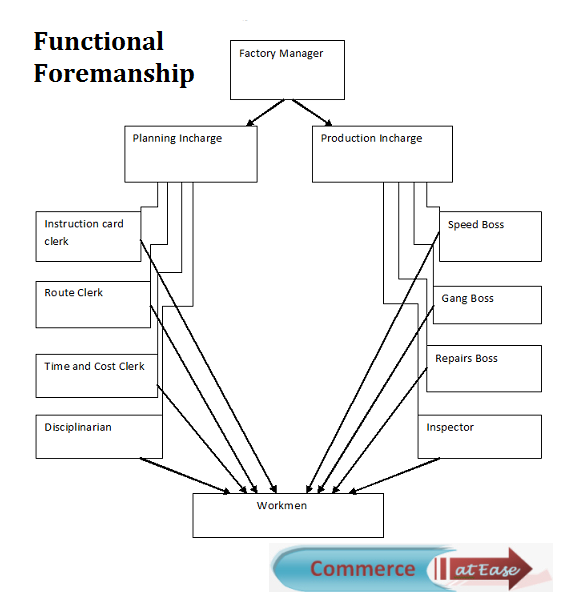(1) Functional Formanship:
This is the technique based on division of labour, and is in favour of separation of planning and execution functions up to the lowest level of the management.
Factory manager will have planning incharge and production incharge under him, handling four supervisors each who will further take the work from workers under them.
The technique of Functional Formanship can be better understood with the help of the following diagram:

(2) Standardization and Simplification of Work
Standardization means setting the limits and criteria to be used in production. It can be used for production process, raw material, time, product, machinery, methods or working conditions.
Simplification means removing extra varieties, sizes and dimensions for reducing cost in terms of time, effort and money.
(3) Work study
Work study relates to the analysis of different aspects of work in order to bring the best out of available resources. It consists of the following four elements:
(a)Method Study
It is concerned with finding the best way of doing the work at the minimum cost and the best quality and maximum satisfaction to the customers.
(b) Motion study
It is the study of movements of men and machines for eliminating the wasteful movements to reduce the time and effort and complete the job efficiently.
(c)Time study
It is the study of time taken by an average worker to complete a well defined job, for the purpose of fixing the standard time.
(d) Fatigue study
Fatigue study is the study of fatigue for the determination of duration and frequency of rest intervals for increasing the productivity of the workers.
(4) Mental Revolution
Taylor advocated the change in the mind set of the workers as well as the management, he said that both these parties should look each other as partners and should cultivate positive attitude towards each other.
(5) Differential Piece Wage System
This technique is concerned with rewarding the efficient worker and penalizing the inefficient worker by giving the higher piece wage rate to the efficient worker and giving the lower piece wage rate to the inefficient worker. Efficiency here means achieving the standard output within the prescribed standard time.
